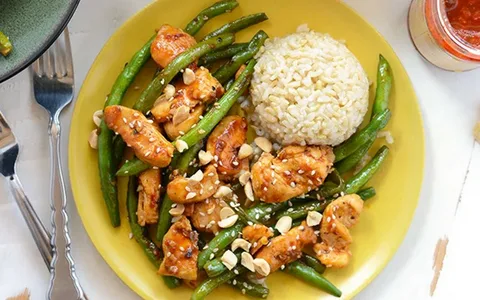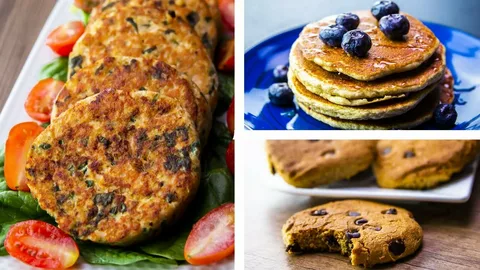It’s no secret that a balanced diet plays a vital role in promoting good health. A critical component of this balance is protein, a nutrient that aids in building and repairing tissues, supporting the immune system, and providing a source of energy. In this blog post, we’ll take a deeper dive into the art of selecting High protein recipes, a key skill to master for anyone seeking to optimize their nutrition.
Understanding the Importance of High protein recipes
The value of incorporating high protein meals into your dietary routine cannot be overstated. Protein functions as a critical part of practically every process within your body.
It’s the foundational element for your muscles, blood, bones, skin, and cartilage. Implementing a High protein recipes can assist in weight management as protein-rich foods tend to make you feel fuller for longer periods, thus leading to a reduction in overall calorie intake.
Protein also boasts a high thermic effect, which means your body expends more energy to digest it compared to fats or carbohydrates. This further assists in managing weight and promoting overall health.
Identifying High Protein Foods
The journey to creating high protein meals starts with being able to identify foods that are naturally rich in protein. Of course, meat is a go-to protein source, with chicken, beef, and pork being prime examples. Seafood is another protein-dense category, with salmon, tuna, and shrimp offering significant amounts. But meat and seafood aren’t the only protein powerhouses out there.
Vegetarians and vegans have numerous protein-rich options at their disposal. Foods such as tofu, lentils, chickpeas, and quinoa pack a protein punch, providing an excellent meatless alternative. Additionally, dairy products like cheese and yogurt are great protein providers, with eggs being another potent protein source.
The key takeaway is this: a variety of foods, both animal-based and plant-based, offer substantial amounts of protein. These food items can serve as the foundation for many high protein meals. Understanding this is an important step in mastering the art of choosing high protein meals that cater to your dietary needs and preferences.
Recognizing the Importance of Protein Quality
A crucial point to consider when selecting high protein meals is the quality of the protein involved. The quality of protein is primarily determined by its amino acid composition. High-quality proteins, also known as complete proteins, have all nine essential amino acids that your body cannot synthesize on its own. These amino acids are indispensable for body functions, including muscle development, tissue repair, and immune support.
Generally, animal-based proteins like poultry, fish, meat, eggs, and dairy are regarded as complete proteins, meaning they contain all nine essential amino acids. However, many plant-based proteins are incomplete, meaning they lack one or more of the essential amino acids. This, however, doesn’t mean you can’t obtain all the necessary amino acids from plant sources. It simply requires a little more planning and variety in your diet. By strategically combining different plant-based foods in your recipes, you can ensure you’re obtaining all the essential amino acids.
Thus, understanding protein quality and strategically incorporating complete proteins or a varied combination of plant-based proteins in your high protein meals can help ensure your body receives all the nutrients it needs. This understanding plays an essential role in the art of choosing high protein meals that are not only delicious but also nutritionally beneficial.
Considering Your Dietary Restrictions and Preferences
In selecting high protein meals, taking into account your unique dietary needs and preferences is crucial. Whether you’re navigating food allergies or adhering to a particular lifestyle diet, this can greatly influence your choice of high protein meals. For example, if you experience lactose intolerance, it would be necessary to avoid recipes with a high dairy content, despite dairy being a significant source of protein.
In a similar vein, those adhering to vegetarian or vegan diets will need to place a higher emphasis on plant-based protein sources, such as lentils, chickpeas, or quinoa, while excluding animal-based proteins. Those on a gluten-free diet will also need to consider their protein sources carefully, avoiding recipes that utilize wheat-based products.
Remember, there’s a wide variety of protein sources available, and many are adaptable to different dietary needs. It’s all about finding the high protein meals that work best for you and your specific dietary requirements.
That being said, always remember to seek a balance of other nutrients as well to ensure overall health. With a little creativity and some planning, you can easily enjoy a delicious and diverse protein-rich diet that aligns perfectly with your personal needs and preferences.
High protein recipes: Factoring in the Calorie Count
When incorporating high protein meals into your diet, it’s vital to pay attention to the overall calorie content of your meals. Even though foods rich in protein can be incredibly beneficial for weight management and overall health, consuming them in excess can still lead to unwanted weight gain.
This is because any consumed calories, even those from healthy foods, can accumulate and contribute to caloric surplus if not balanced out with physical activity. To prevent this, it’s beneficial to look closely at the portion sizes and total calories in the high protein meals you choose.
Consider how these numbers fit into your daily caloric needs, which can vary depending on factors like age, sex, weight, and physical activity level. By being mindful of the total calorie content and not just the protein content, you can maintain a balanced diet that supports both your health and weight goals. Remember, the key is not just about eating High protein recipes, but about creating a balanced, well-rounded diet that aligns with your specific nutritional needs and goals.
Ensuring Variety in Your Meal Plan
Variety is the spice of life, and this holds true when it comes to your high protein meal plan. Consuming the same meals every day can lead to a lack of enthusiasm towards your food, and more importantly, it could result in nutritional gaps. The goal should be to incorporate a wide array of proteins, along with carbohydrates and fats, into your diet to maintain interest and ensure nutritional completeness.
Think outside the box with your protein sources. Perhaps you could swap chicken for salmon one night, or replace your usual beef with lentils. And don’t forget about the protein-rich grains like quinoa and farro. These small changes can make a world of difference in adding variety to your meals while still maintaining a high protein content.
You might also consider experimenting with different cooking techniques or ethnic cuisines. This can transform familiar ingredients into exciting new dishes and keep your taste buds guessing. For instance, tofu can be stir-fried, baked, or used in a curry.
Additionally, don’t underestimate the importance of various fruits, vegetables, and fats in your meal plan. They may not be high in protein, but they deliver essential nutrients and can greatly contribute to the flavor and enjoyment of your meals. A meal that’s high in protein, balanced with other nutrients, and flavorful will not only be good for your health but also your palate.
Creating a varied meal plan is not just about diversifying your protein sources. It’s about exploring different flavors, textures, and culinary experiences while still meeting your nutritional goals. With a bit of creativity and planning, you can ensure that your high-protein diet is anything but monotonous.
 Utilizing Online Resources for High protein meals
Utilizing Online Resources for High protein meals
In the digital age, an abundance of online resources are available that offer a wealth of high protein meals suited for various dietary needs, tastes, and cooking skills. You can find a multitude of dedicated health-focused websites, blogs, and mobile apps that provide a diverse range of high protein meals, often accompanied by nutritional information and serving sizes. These tools can significantly simplify your meal planning process, ensuring that your high-protein diet stays on track.
Through these resources, you can discover a variety of innovative and delicious high protein meals that cater to different cuisines and cooking styles. From high protein vegetarian meals featuring lentils and chickpeas to seafood-based dishes rich in protein, the options are practically limitless. Many of these online platforms also allow you to filter recipes based on specific dietary restrictions such as gluten-free, dairy-free, or vegan.
Additionally, you can find resources that provide helpful cooking tips and techniques, which can enhance your culinary skills and enable you to get the most out of your protein-rich ingredients. Some platforms also have interactive community features, where you can share your own recipes, get inspiration from others, and engage in discussions about healthy eating.
Embracing these digital tools can make the journey of choosing and preparing high protein meals more enjoyable and less daunting. Therefore, leveraging online resources can be a key strategy in mastering the art of choosing high protein meals.
FAQs
Q: What are some examples of high protein foods?
A: Foods rich in protein include meat, such as chicken, beef, and pork, seafood like salmon, tuna, and shrimp, and dairy products. Vegetarian and vegan options include tofu, lentils, chickpeas, quinoa, and many more.
Q: What are complete proteins?
A: Complete proteins are those that contain all nine essential amino acids our body cannot produce. Most animal-based proteins are complete, but plant-based proteins can be combined strategically to get all essential amino acids.
Q: How can I manage my caloric intake while on a high protein diet?
A: It’s crucial to consider portion sizes and total calories in high protein meals. Ensure these numbers fit into your daily caloric needs which depend on factors like age, sex, weight, and activity level.
Q: How can I add variety to my high protein meal plan?
A: Experiment with different protein sources, cooking techniques, and cuisines. Diversify with fruits, vegetables, and fats for nutritional completeness. Utilize online resources for finding new and exciting recipes.
Q: Where can I find high protein recipes?
A: Numerous online resources offer a plethora of high protein recipes, often accompanied by nutritional information. From dedicated health websites and blogs to mobile apps, you’ll find a variety of recipes catering to different tastes and dietary needs.
Conclusion
Choosing high protein meals doesn’t have to be daunting or monotonous. It starts with understanding the importance of protein in your diet and identifying rich sources from both animal and plant-based foods. Remember that the quality of protein, your unique dietary needs, and overall calorie content are all crucial factors to consider in your selection process. Adding variety to your meals not only keeps your diet exciting but also ensures nutritional completeness. Online resources can be a valuable asset in your journey, offering a myriad of diverse, delicious recipes, and community support. Each step brings you closer to mastering the art of choosing high protein meals, thus paving the way to better health and wellness. Armed with these strategies, you’re ready to explore the world of high protein meals, one flavorful, nutritious dish at a time.
| Other Good Articles to Read |
| skank blogs |
| unreal blogs |
| tba blogs |
| all city forums |
| dany blogs |
| refuge blogs |
| the music blogs |
| key forums |
| the big blog theory |
| joe blogs |
| blogs 4 me |
| Blogs Emon |
| Related Business Listings |
| Contact Directory |
| Local Business Profiles |
